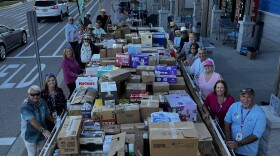Despite the U.S. Geological Survey warning that waves and storm surge from Hurricane Helene would remake the length of the shoreline on Florida’s West Coast, that is exactly where the agency's scientists attached wave sensors late Wednesday between Venice and Panama City.
The USGS has been warning since Tuesday that potential impacts from Helene include life-threatening storm surge along the entire west coast of the Florida peninsula and Florida Big Bend, as well as devastating hurricane-force winds across portions of northern Florida.
In that zone, there are now 13 sensors to measure water levels and give insight into factors such as wave height and frequency, storm tide, and storm surge.
The sensors were placed many hours before the outer bands of the storm reached the area.
“Studying Helene and other storms gives real-world insight that’s valuable in helping with community preparedness,” said Kevin Grimsley, a director with the USGS Caribbean-Florida Water Science Center. “Wave sensors capture data at a very high frequency, so we are able to receive extremely detailed and comprehensive records.”
The resulting information can be used to fine-tune future storm surge and coastal change models and forecasts as well as improve flood insurance maps and building codes to improve the structural designs of buildings.
The wave sensors are housed in vented aluminum pipes a few inches wide and about a foot long. They were installed on bridges, piers, and other structures that have a good chance of surviving the storm.
The sensors were online early Thursday and reporting data to a website from the devices listed as having cellular service and GPS location — probably a cell phone — and the device’s location was as non-scientific as it gets: “attached to pier pilling. 9th pilling from start of pier. “
Every worker installing a sensor was either within the future windfield or forecast path of the northward-moving Hurricane Helene that the USGS was warning would be so powerful that it would change the shape of Florida’s West Coast — all of it.
Beaches where they were would be inundated, the sand would be dragged away by waves, and the dunes would be flattened everywhere along Florida’s West Coast as the hurricane moved north overnight.
“The coastal change forecast for Helene's impact to the Florida West Coast is significant because Helene is predicted to be a large and powerful storm with high waves and storm surge, even if it stays offshore,” said Kara Doran, a USGS coastal scientist. “With Florida's low elevation and this significant forecast, we might see more flooding immediately behind dunes and into beachside communities.”
After Hurricane Helene moves through, the USGS scientists will retrieve the instruments and analyze the data collected.
It is assumed after installing the sensors in advance of the storm, the same crews then moved somewhere else very quickly to wait until it was time to return to places like the ninth piling from the start of the pier to unhook the device.
Environmental reporting for WGCU is funded in part by VoLo Foundation, a non-profit with a mission to accelerate change and global impact by supporting science-based climate solutions, enhancing education, and improving health.
Sign up for WGCU's monthly environmental newsletter, the Green Flash, today.
WGCU is your trusted source for news and information in Southwest Florida. We are a nonprofit public service, and your support is more critical than ever. Keep public media strong and donate now. Thank you.








